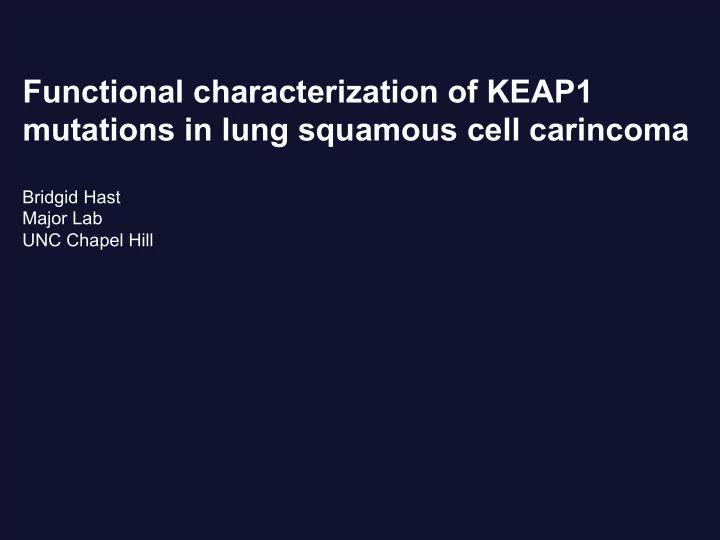

Functional characterization of KEAP1 mutations in lung squamous cell carincoma Bridgid Hast Major Lab UNC Chapel Hill
KEAP1/NRF2 regulates intracellular redox homeostasis CUL3
NRF2 activity modulates survival via redox homeostasis NRF2 target genes NRF2 KEAP1 -Heme oxygenase 1 (HMOX1) null null -Glutathione synthesis (GCS) Risk for Disease -NADH quinone oxidoreductase 1 (NQO1) Effective Prevention -Multidrug resistance proteins (MRP) Cancer Neurodegeration NRF2 mediated transcription *Mitigate acute spikes in ROS *Chemotherapeutic/xenobiotic clearance *Control metabolically-derived ROS
Pathway mutations in KEAP1/NRF2 signaling occur in squamous cell lung carcinoma -178 total squamous cell lung carcinomas analyzed -Mutations in KEAP1 and NRF2 are mutually exclusive -Primarily in classical subtype -Collectively KEAP1, NRF2, and CUL3 mutations are altered in 34% of total samples The Cancer Genome Atlas Research Network, Nature 2012
NRF2-mediated transcription KEAP1 mutations exhibit differential suppression of Firefly/ Renilla 0.2 0.4 0.6 0.8 1.2 0 1 GFP KEAP1 R554Q R320Q W554C R470C G423V N469fs G480W D422N G333C L231V P318L G186R S243C P318del V167F R71K V155F
KEAP1 mutants differentially bind to interacting proteins
KEAP1 mutants differentially bind to interacting proteins
KEAP1 mutants differentially bind to interacting proteins
The KEAP1 mutants cluster into four classes Class I: Strong binders of NRF2 but cannot suppress NRF2-mediated transcription NTR BTB IVR KELCH KELCH KELCH KELCH KELCH KELCH CTR 1-60 61-179 180-314 315-359 361-410 459-504 506-551 553-598 412-457 599-624 G186R D422N R320Q R470C V155F S243L G423V Class II: Do not bind NRF2 and cannot suppress NRF2 NTR BTB IVR KELCH KELCH KELCH KELCH KELCH CTR KELCH 1-60 61-179 180-314 315-359 361-410 459-504 506-551 553-598 599-624 412-457 N469fs R554Q W544C Class III: Weakly bind NRF2 and cannot suppress NRF2 NTR BTB IVR KELCH KELCH KELCH KELCH KELCH CTR KELCH 1-60 61-179 180-314 315-359 361-410 459-504 506-551 553-598 599-624 412-457 P318L G480W V167F G333C Class IV: Behave like wildtype NTR BTB IVR KELCH KELCH KELCH KELCH KELCH CTR KELCH 1-60 61-179 180-314 315-359 361-410 459-504 506-551 553-598 599-624 412-457 S224Y P318del R71K L231V
KEAP1 mutants differentially bind to interacting proteins -“Superbinders” only bind more 1.2 NRF2 Firefly/ Renilla 1 0.8 - Cannot suppress NRF2-mediated 0.6 transcription 0.4 - Exhibit increased NRF2 half-life 0.2 0 GFP KEAP1 R554Q R320Q W554C R470C N469fs D422N G333C G186R S243C V167F V155F - Have enhanced cell viability in G423V L231V P318L P318del R71K G480W response to chemotherapeutic insult Mechanism?
“Superbinders”: slow cyclers or subpar structures? NRF2 NRF2 DLG and ETGE KELCH D422 R470 IVR R320 P318 90° R470 D422 1.2 -Class I mutants are on “bottom” of KELCH domain, not at KELCH/NRF2 Firefly/ Renilla 1 interface 0.8 -Mutants in IVR and linker between IVR and KELCH are also in Class I. 0.6 Predicted to be near IVR/BTB interface 0.4 0.2 -More likely that Class I mutants perturb KEAP1 structure than act as 0 “superbinders” GFP KEAP1 R554Q R320Q W554C R470C G423V N469fs G480W D422N G333C L231V P318L G186R S243C P318del V167F R71K V155F
KEAP1 cysteine residues are stress-specific -C151 forms adducts with electrophiles -H129, K131, R135, K150, and H154 comprise microenvironment that alters reactivity of C151 -H225/C226 and C613 are reactive to heavy metals -C288 specific reactivity to alkenals Is cysteine reactivity in KEAP1 altered in cancer? McMahon et al, PNAS 2010
KEAP1 mutations cluster Approximate Residue 240 320-350 430 Cys 241, 249, 319, 368, 434, 489 have been shown to react with electrophilic fatty acids as well as Are clustered mutations sulforaphane “pointing” to important regions of KEAP1?
KEAP1 mutations are hypomorphic and can be further inactivated by interacting proteins -Overexpression of the ETGE-containing protein DPP3 further (DPP3) activates NRF2 signaling in a KEAP1 mutant background -DPP3 is overexpressed in tumor verses normal lung squamous cell carcinoma (p=4.6e-14)
Summary -Mutations in KEAP1 from lung squamous cell carcinoma can be grouped into four phenotypic classes -The “superbinder” class exhibits enhanced NRF2 activity and stability, and is likely a result of structural changes in the KEAP1 homodimer -KEAP1 mutations in cancer cluster around cysteines with reactivity to electrophilic compounds -Overexpression of ETGE-containing proteins can further activate NRF2 activity in a KEAP1 mutant background
Major Lab Hayes Lab Ben Major Neil Hayes Erica Cloer Matt Wilkerson Ning Zheng (U. Washington) Kathleen Mulvaney Dennis Goldfarb TCGA Research Network Priscila Siesser Matt Walker Feng Yan Alex Rabinowitz
Questions?
Recommend
More recommend